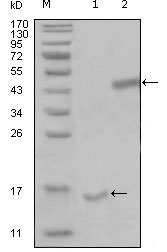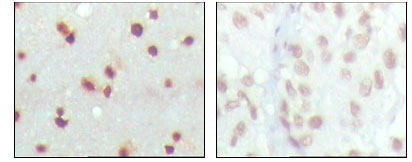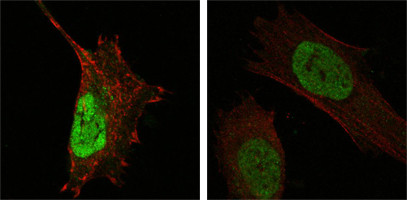PARL Antibody
Purified Mouse Monoclonal Antibody
- 产品详情
- 实验流程
Application
| WB, E |
|---|---|
| Primary Accession | Q9H300 |
| Reactivity | Human |
| Host | Mouse |
| Clonality | Monoclonal |
| Clone Names | 8C4B2; 1H12E10 |
| Isotype | IgG2b |
| Calculated MW | 42190 Da |
| Description | PARL: presenilin associated, rhomboid-like. This gene encodes a mitochondrial integral membrane protein. Following proteolytic processing of this protein, a small peptide (P-beta) is formed and translocated to the nucleus. This gene may be involved in signal transduction via regulated intramembrane proteolysis of membrane-tethered precursor proteins. Variation in this gene has been associated with increased risk for type 2 diabetes. Alternative splicing results in multiple transcript variants encoding different isoforms. |
| Immunogen | Purified recombinant fragment of PARL (aa112-167) expressed in E. Coli. |
| Formulation | Ascitic fluid containing 0.03% sodium azide. |
| Gene ID | 55486 |
|---|---|
| Other Names | Presenilins-associated rhomboid-like protein, mitochondrial, 3.4.21.105, Mitochondrial intramembrane cleaving protease PARL, P-beta, Pbeta, PARL, PSARL |
| Dilution | WB~~1/500 - 1/2000 E~~N/A |
| Storage | Maintain refrigerated at 2-8°C for up to 6 months. For long term storage store at -20°C in small aliquots to prevent freeze-thaw cycles. |
| Precautions | PARL Antibody is for research use only and not for use in diagnostic or therapeutic procedures. |
| Name | PARL |
|---|---|
| Synonyms | PSARL |
| Function | Required for the control of apoptosis during postnatal growth. Essential for proteolytic processing of an antiapoptotic form of OPA1 which prevents the release of mitochondrial cytochrome c in response to intrinsic apoptotic signals (By similarity). Required for the maturation of PINK1 into its 52kDa mature form after its cleavage by mitochondrial-processing peptidase (MPP) (PubMed:22354088). Promotes cleavage of serine/threonine-protein phosphatase PGAM5 in damaged mitochondria in response to loss of mitochondrial membrane potential (PubMed:22915595). Mediates differential cleavage of PINK1 and PGAM5 depending on the health status of mitochondria, disassociating from PINK1 and associating with PGAM5 in response to mitochondrial membrane potential loss (PubMed:22915595). Required for processing of CLPB into a form with higher protein disaggregase activity by removing an autoinhibitory N-terminal peptide (PubMed:28288130, PubMed:32573439). Promotes processing of DIABLO/SMAC in the mitochondrion which is required for DIABLO apoptotic activity (PubMed:28288130). Also required for cleavage of STARD7 and TTC19 (PubMed:28288130). Promotes changes in mitochondria morphology regulated by phosphorylation of P-beta domain (PubMed:14732705, PubMed:17116872). |
| Cellular Location | Mitochondrion inner membrane; Multi-pass membrane protein |
Research Areas
For Research Use Only. Not For Use In Diagnostic Procedures.
Application Protocols
Provided below are standard protocols that you may find useful for product applications.
REFERENCES
1. J Alzheimers Dis. 2001 Apr;3(2):181-190. 2. Proc Natl Acad Sci U S A. 2002 Dec 24;99(26):16899-903. 3. Nature. 2003 May 29;423(6939):537-41.
终于等到您。ABCEPTA(百远生物)抗体产品。
点击下方“我要评价 ”按钮提交您的反馈信息,您的反馈和评价是我们最宝贵的财富之一,
我们将在1-3个工作日内处理您的反馈信息。
如有疑问,联系:0512-88856768 tech-china@abcepta.com.























 癌症的基本特征包括细胞增殖、血管生成、迁移、凋亡逃避机制和细胞永生等。找到癌症发生过程中这些通路的关键标记物和对应的抗体用于检测至关重要。
癌症的基本特征包括细胞增殖、血管生成、迁移、凋亡逃避机制和细胞永生等。找到癌症发生过程中这些通路的关键标记物和对应的抗体用于检测至关重要。 为您推荐一个泛素化位点预测神器——泛素化分析工具,可以为您的蛋白的泛素化位点作出预测和评分。
为您推荐一个泛素化位点预测神器——泛素化分析工具,可以为您的蛋白的泛素化位点作出预测和评分。 细胞自噬受体图形绘图工具为你的蛋白的细胞受体结合位点作出预测和评分,识别结合到自噬通路中的蛋白是非常重要的,便于让我们理解自噬在正常生理、病理过程中的作用,如发育、细胞分化、神经退化性疾病、压力条件下、感染和癌症。
细胞自噬受体图形绘图工具为你的蛋白的细胞受体结合位点作出预测和评分,识别结合到自噬通路中的蛋白是非常重要的,便于让我们理解自噬在正常生理、病理过程中的作用,如发育、细胞分化、神经退化性疾病、压力条件下、感染和癌症。








